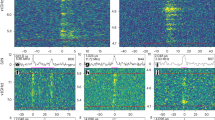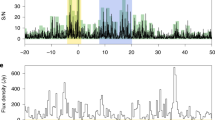Abstract
Modern astrophysics is undergoing a revolution. As detector technology has advanced, and astronomers have been able to study the sky with finer temporal detail, a rich diversity of sources that vary on timescales from years down to a few nanoseconds has been found. Among these are fast radio bursts, which exhibit pulses of millisecond duration and anomalously high dispersion compared to Galactic pulsars, first seen a decade ago. Since then, a new research community has been actively working on a variety of experiments and developing models to explain this new phenomenon, and devising ways to use them as astrophysical tools. In this Perspective, I describe how astronomers have reached this point, review the highlights from the first decade of research in this field, give some current breaking news, and look ahead to what might be expected in the next few years.
This is a preview of subscription content, access via your institution
Access options
Access Nature and 54 other Nature Portfolio journals
Get Nature+, our best-value online-access subscription
$29.99 / 30 days
cancel any time
Subscribe to this journal
Receive 12 digital issues and online access to articles
$119.00 per year
only $9.92 per issue
Buy this article
- Purchase on Springer Link
- Instant access to full article PDF
Prices may be subject to local taxes which are calculated during checkout



Similar content being viewed by others
References
Cordes, J. M., Lazio, T. J. W. & McLaughlin, M. A. The dynamic radio sky. New Astron. Rev. 48, 1459–1472 (2004).
Lorimer, D. R., Bailes, M., McLaughlin, M. A., Narkevic, D. J. & Crawford, F. A bright millisecond radio burst of extragalactic origin. Science 318, 777–780 (2007).
Petroff, E. et al. FRBCAT: The fast radio burst catalogue. Publ. Astron. Soc. Aus. 33, e045 (2016).
Hewish, A., Bell, S. J., Pilkington, J. D. H., Scott, P. F. & Collins, R. A. Observation of a rapidly pulsating radio source. Nature 217, 709–713 (1968).
Manchester, R. N., Hobbs, G. B., Teoh, A. & Hobbs, M. The Australia Telescope National Facility pulsar catalogue. Astron. J. 129, 1993–2006 (2005).
Burns, W. R. & Clark, B. G. Pulsar search techniques. Astron. Astrophys. 2, 280–287 (1969).
Staelin, D. H., Reifenstein, I. & Edward, C. Pulsating radio sources near the Crab Nebula. Science 162, 1481–1483 (1968).
Mickaliger, M. B. et al. A giant sample of giant pulses from the Crab pulsar. Astrophys. J. 760, 64 (2012).
Cordes, J. M., Bhat, N. D. R., Hankins, T. H., McLaughlin, M. A. & Kern, J. The brightest pulses in the Universe: Multifrequency observations of the Crab pulsar’s giant pulses. Astrophys. J. 612, 375–388 (2004).
Hawking, S. W. Black hole explosions. Nature 248, 30–31 (1974).
Rees, M. J. A better way of searching for black-hole explosions. Nature 266, 333 (1977).
Colgate, S. A. Electromagnetic pulse from supernovae. Astrophys. J. 198, 439–445 (1975).
Phinney, S. & Taylor, J. H. A sensitive search for radio pulses from primordial black holes and distant supernovae. Nature 277, 117–118 (1979).
Linscott, I. R. & Erkes, J. W. Discovery of millisecond radio bursts from M 87. Astrophys. J. Lett. 236, L109–L113 (1980).
Taylor, J. H., Backus, P. R. & Damashek, M. No radio pulses from M87. Astrophys. J. Lett. 244, L65–L68 (1981).
Nice, D. J. Radio pulses along the Galactic Plane. Astrophys. J. 513, 927–932 (1999).
McLaughlin, M. A. & Cordes, J. M. Searches for giant pulses from extragalactic pulsars. Astrophys. J. 596, 982–996 (2003).
McLaughlin, M. A. et al. Transient radio bursts from rotating neutron stars. Nature 439, 817–820 (2006).
Yao, J. M., Manchester, R. N. & Wang, N. A new electron-density model for estimation of pulsar and FRB distances. Astrophys. J. 835, 29 (2017).
Burke-Spolaor, S., Bailes, M., Ekers, R., Macquart, J.-P. & Crawford, F. III Radio bursts with extragalactic spectral characteristics show terrestrial origins. Astrophys. J. 727, 18 (2011).
Petroff, E. et al. Identifying the source of perytons at the Parkes radio telescope. Mon. Not. R. Astron. Soc. 451, 3933–3940 (2015).
Keane, E. F., Stappers, B. W., Kramer, M. & Lyne, A. G. On the origin of a highly dispersed coherent radio burst. Mon. Not. R. Astron. Soc. 425, L71–L75 (2012).
Thornton, D. et al. A population of fast radio bursts at cosmological distances. Science 341, 53–56 (2013).
Spitler, L. G. et al. Fast radio burst discovered in the Arecibo Pulsar ALFA Survey. Astrophys. J. 790, 101 (2014).
Masui, K. et al. Dense magnetized plasma associated with a fast radio burst. Nature 528, 523–525 (2015).
Caleb, M. et al. The first interferometric detections of fast radio bursts. Mon. Not. R. Astron. Soc. 468, 3746–3756 (2017).
Farah, W. et al. FRB microstructure revealed by the real-time detection of FRB170827. Mon. Not. R. Astron. Soc. 478, 1209–1217 (2018).
Bannister, K. W. et al. The detection of an extremely bright fast radio burst in a phased array feed survey. Astrophys. J. Lett. 841, L12 (2017).
Shannon, R. M. et al. The dispersion–brightness relation for fast radio bursts from a wide-field survey. Nature https://doi.org/10.1038/s41586-018-0588-y (2018).
Boyle, P. C. & CHIME/FRB Collaboration. First detection of fast radio bursts between 400 and 800 MHz by CHIME/FRB. The Astronomer’s Telegram 11901 (2018).
Inoue, S. Probing the cosmic reionization history and local environment of gamma-ray bursts through radio dispersion. Mon. Not. R. Astron. Soc. 348, 999–1008 (2004).
Spitler, L. G. et al. A repeating fast radio burst. Nature 531, 202–205 (2016).
Scholz, P. et al. Simultaneous X-ray, gamma-ray, and radio observations of the repeating fast radio burst FRB 121102. Astrophys. J. 846, 80 (2017).
Law, C. J. et al. A multi-telescope campaign on FRB 121102: Implications for the FRB population. Astrophys. J. 850, 76 (2017).
Gajjar, V. et al. Highest frequency detection of FRB 121102 at 4-8 GHz using the Breakthrough Listen digital backend at the Green Bank Telescope. Astrophys. J. 863, 2 (2018).
Chatterjee, S. et al. A direct localization of a fast radio burst and its host. Nature 541, 58–61 (2017).
Michilli, D. et al. An extreme magneto-ionic environment associated with the fast radio burst source FRB 121102. Nature 553, 182–185 (2018).
Tendulkar, S. P. et al. The host galaxy and redshift of the repeating fast radio burst FRB 121102. Astrophys. J. Lett. 834, L7 (2017).
Marcote, B. et al. The repeating fast radio burst FRB 121102 as seen on milliarcsecond angular scales. Astrophys. J. Lett. 834, L8 (2017).
Margalit, B. et al. Unveiling the engines of fast radio bursts, super-luminous supernovae, and gamma-ray bursts. Mon. Not. R. Astron. Soc. 481, 2407–2426 (2018).
Eatough, R. P. et al. A strong magnetic field around the supermassive black hole at the centre of the Galaxy. Nature 501, 391–394 (2013).
Palaniswamy, D., Li, Y. & Zhang, B. Are There Multiple Populations of Fast Radio Bursts? Astrophys. J. Lett. 854, L12 (2018).
Fishman, G. J. Gamma-ray bursts: an overview. Publ. Astron. Soc. Pacific 107, 1145 (1995).
Lingam, M. & Loeb, A. Fast radio bursts from extragalactic light sails. Astrophys. J. Lett. 837, L23 (2017).
Maoz, D. et al. Fast radio bursts: the observational case for a Galactic origin. Mon. Not. R. Astron. Soc. 454, 2183–2189 (2015).
Lyubarsky, Y. & Ostrovska, S. Induced Scattering Limits on Fast Radio Bursts from Stellar Coronae. Astrophys. J. 818, 74 (2016).
Falcke, H. & Rezzolla, L. Fast radio bursts: the last sign of supramassive neutron stars. Astron. Astrophys. 562, A137 (2014).
Fuller, J. & Ott, C. D. Dark matter-induced collapse of neutron stars: a possible link between fast radio bursts and the missing pulsar problem. Mon. Not. R. Astron. Soc. 450, L71–L75 (2015).
Totani, T. Cosmological fast radio bursts from binary neutron star mergers. Publ. Astron. Soc. Japan 65, L12 (2013).
Yamasaki, S., Totani, T. & Kiuchi, K. Repeating and non-repeating fast radio bursts from binary neutron star mergers. Publ. Astron. Soc. Japan 70, 39 (2018).
Mingarelli, C. M. F., Levin, J. & Lazio, T. J. W. Fast radio bursts and radio transients from black hole batteries. Astrophys. J. Lett. 814, L20 (2015).
Kashiyama, K., Ioka, K. & Mészáros, P. Cosmological fast radio bursts from binary white dwarf mergers. Astrophys. J. Lett. 776, L39 (2013).
Abramowicz, M. A., Bejger, M. & Wielgus, M. Collisions of neutron stars with primordial black holes as fast radio bursts engines. Preprint at https://arxiv.org/abs/1704.05931 (2018).
Kavic, M., Simonetti, J. H., Cutchin, S. E., Ellingson, S. W. & Patterson, C. D. Transient pulses from exploding primordial black holes as a signature of an extra dimension. J. Cosmo. Astropart. Phys. 11, 017 (2008).
Cordes, J. M. & Wasserman, I. Supergiant pulses from extragalactic neutron stars. Mon. Not. R. Astron. Soc. 457, 232–257 (2016).
Lyutikov, M., Burzawa, L. & Popov, S. B. Fast radio bursts as giant pulses from young rapidly rotating pulsars. Mon. Not. R. Astron. Soc. 462, 941–950 (2016).
Metzger, B. D., Berger, E. & Margalit, B. Millisecond magnetar birth connects FRB 121102 to superluminous supernovae and long-duration gamma-ray bursts. Astrophys. J. 841, 14 (2017).
Nicholl, M. et al. Empirical constraints on the origin of fast radio bursts: volumetric rates and host galaxy demographics as a test of millisecond magnetar connection. Astrophys. J. 843, 84 (2017).
Barrau, A., Rovelli, C. & Vidotto, F. Fast radio bursts and white hole signals. Phys. Rev. D 90, 127503 (2014).
Zadorozhna, L. V. Fast radio bursts as electromagnetic radiation from cusps on superconducting cosmic strings. Advances in Astronomy and Space Physics 5, 43–50 (2015).
Cao, X.-F. & Yu, Y.-W. Superconducting cosmic string loops as sources for fast radio bursts. Phys. Rev. D 97, 023022 (2018).
Caleb, M. et al. Are the distributions of fast radio burst properties consistent with a cosmological population? Mon. Not. R. Astron. Soc. 458, 708–717 (2016).
Rane, A. A Study of the Fast Radio Burst Population. PhD thesis, West Virginia Univ. (2017).
Bhandari, S. et al. The SUrvey for Pulsars and Extragalactic Radio Bursts - II. New FRB discoveries and their follow-up. Mon. Not. R. Astron. Soc. 475, 1427–1446 (2018).
Fialkov, A., Loeb, A. & Lorimer, D. R. Enhanced rates of fast radio bursts from galaxy clusters. Astrophys. J. 863, 132 (2018).
Keane, E. F. The future of fast radio burst science. Nat. Astron. https://doi.org/10.1038/s41550-018-0603-0 (2018).
Rajwade, K. M. & Lorimer, D. R. Detecting fast radio bursts at decametric wavelengths. Mon. Not. R. Astron. Soc. 465, 2286–2293 (2017).
Li, D. et al. FAST in Space: Considerations for a multibeam, multipurpose survey using China’s 500-m Aperture Spherical Radio Telescope (FAST). IEEE Microwave Magazine 19, 112–119 (2018).
Sanidas, S. et al. MeerTRAP: A pulsar and fast transients survey with MeerKAT. Proc. Int. Astron.Union 13, 406–407 (2017).
Bloemen, S. et al. MeerLICHT and BlackGEM: custom-built telescopes to detect faint optical transients. Proc. SPIE 9906, 990664 (2016).
Lyutikov, M. & Lorimer, D. R. How else can we detect fast radio bursts? Astrophys. J. Lett. 824, L18 (2016).
Stappers, B. W. The square kilometre array and the transient universe. Philos. Trans. Royal Soc. A 371, 20120284 (2013).
Author information
Authors and Affiliations
Corresponding author
Ethics declarations
Competing interests
The author declares no competing interests.
Additional information
Publisher’s note: Springer Nature remains neutral with regard to jurisdictional claims in published maps and institutional affiliations.
Rights and permissions
About this article
Cite this article
Lorimer, D.R. A decade of fast radio bursts. Nat Astron 2, 860–864 (2018). https://doi.org/10.1038/s41550-018-0607-9
Received:
Accepted:
Published:
Issue Date:
DOI: https://doi.org/10.1038/s41550-018-0607-9
This article is cited by
-
Luminosity distribution of fast radio bursts from CHIME/FRB Catalog 1 by means of the updated Macquart relation
Astrophysics and Space Science (2022)
-
GrailQuest: hunting for atoms of space and time hidden in the wrinkle of Space-Time
Experimental Astronomy (2021)
-
The physical mechanisms of fast radio bursts
Nature (2020)
-
Hopes and concerns for astronomy of satellite constellations
Nature Astronomy (2020)
-
Fast radio bursts
The Astronomy and Astrophysics Review (2019)



